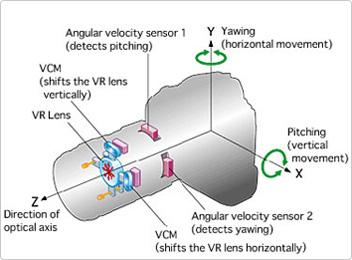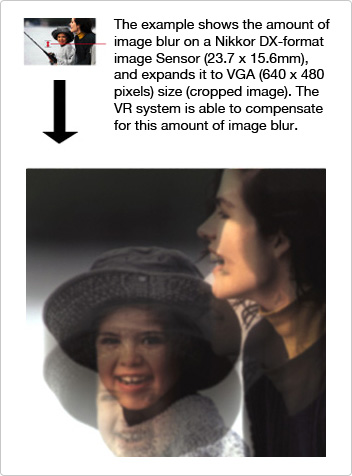VR (Vibration-Reduction)

Vibration Reduction (VR) systems compensate for image blur caused by small, involuntary movements (from unsteady hands, shooting from a moving vehicle, etcs) Known as camera shake. VR can be found in many Nikon products, such as interchangeable lenses for SLR cameras, digital cameras and binoculars. In this article, the principles of VR will be explained by using an interchangeable SLR lens as an example.
Fig. 1 shows how the light from subject (A) reaches focal plane (A’) through the lens. Without camera shake, light from A converges at A’. However, if the camera’s lens moves up or down (ie. camera shake — see arrow) the light from A will converge on A”. This gap results in image blur. The VR System works by adjusting the lens to compensate for camera shake and to make sure light from A converges on A’. Each VR Unit contains a VR lens elements and driving motors to make this happen.
Fig. 1: For the sake of simplicity, this diagram shows only one lens element. In actuality, an interchangeable VR lens has many lens elements.
To compensate for image blur caused by camera shake, the angular velocity (amount of camera shake) should be detected accurately. Two angular velocity sensors are used in the VR System. One detects "pitching" (vertical movement), while the other detects "yawing" (horizontal movement). Diagonal movements are detected by combining the results of both sensors. These sensors detect camera movement as angular velocity every 1/1000 second. Angular velocity data is sent to a microcomputer built right into lens, which then calculates the amount of compensation needed. After this data is transmitted to the VR unit, the adjustments are made instantaneously. (Fig. 2)

Fig. 2
Fig. 3

Simulated image.
The built-in microcomputer calculates the amount of lens movement necessary using data from the angular velocity sensors. Commands are sent to two VCMs (Voice Coil Motors), which move the VR lens in a particular direction. This is controlled by the electric current inside the VCM's magnetic field. One motor controls the vertical, while the other controls horizontal, with both working together to compensate for diagonal movement.
With most interchangeable VR lenses, VR operation is activated by lightly pressing on the shutter release button. When a photographer is recomposing a picture while keeping the shutter release button half pressed, the system can instantly tell whether camera movement is intentional or caused by camera shake and act accordingly. For example VR does not compensate for recomposing movement that camera movement, because if it did, the photographer could have difficulty accomplishing the desired composition.
Nikon’s VR System changes operation algorithms when the shutter release button is lightly pressed and during exposure. Therefore, when the shutter release button is lightly pressed, the VR lens gives you a smooth viewfinder image. During the exposure, however, the algorithm changes to compensate for every slight movement. What’s more, just before exposure, the VR lens will reset to central position (optical axis) from an off-centered position which is a result of VR operation during the shutter release button is lightly pressed. Since the shift amount of the VR lens is limited, this operation maximizes VR effects as well as optical performance. Only Nikon has this "Centering Before Exposure" feature. (Fig. 3)
Image blur caused by camera shake generally occurs with shutter speeds slower than 1/[focal length] in 35mm format equivalent. Nikon’s latest VRII lenses offer the ability to shoot at shutter speeds 4 steps faster.
When the AF-S DX VR Zoom-Nikkor 18-200mm f/3.5-5.6G IF-ED is used at 200mm focal length: A photographer shooting at a 1/125 second shutter speed may avoid camera shake 70% of the time. By using the VR system, he or she can achieve the same results at a speed of 1/8 second (4 steps slower than 1/125 second: 1/60-1/30-1/15-1/8)*.
- *Effect of VR System varies by photographer.
In addition to the "Centering Before Exposure" System, Nikon’s VR System offers Normal mode and Active mode, original technologies to help you cover various shooting situations. In Normal mode, slow and wide camera movement is regarded as recomposing movement and VR operation is controlled accordingly. In Active mode, however, even large amounts of camera movement are compensated for to give a smooth viewfinder image. This mode is quite useful when shooting from a moving vehicle or some other unstable position.
A tripod is generally believed to prevent image blur, but camera shake can occur due to the movements of the quick-return mirror or shutter curtain, or winds. This camera shake movement has different characteristics compared to normal camera shake caused by handheld shooting. Nikon’s VR technology makes it possible to detect and compensate this type of camera shake, as well. (Note: Some VR lenses do not have this function.)
Nikon has developed its original VR technologies by rigorously studying the various aspects of camera shake.
Renewed March 2008
